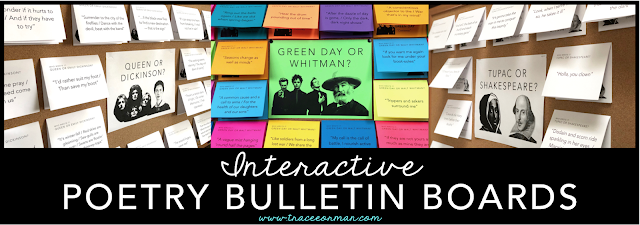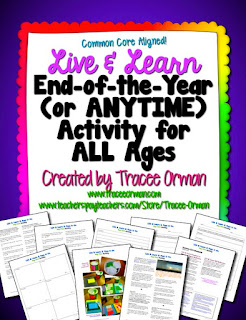Every single day presents an opportunity to inspire creative thought in your classroom. Whether you are reading a short story, writing an argument essay, or having a formal classroom debate, you can incorporate quick creative activities in the form of bell ringers, exit slips, enrichment projects, and more.
SHORT & QUICK CREATIVE ASSESSMENTS
Use
creative questions during discussions or as bell ringers or exit slips. When you are reading a novel, short story, poem, or even a nonfiction piece, you can use questions that force students to think differently about the characters, plot, setting, tone, and author's purpose. My
Creative Questions for Any Novel or Story can help! All of the question prompts (there are 180 total prompts) are aligned with the Common Core State Standards and not only require students to think creatively but critically, as well. They may seem simple, but they do force students to analyze, interpret, and synthesize elements of the text.
Example questions include:
• What is the most embarrassing thing that could happen right now in the story? Why? This question requires the student to think about past events and future predictions, character traits and motivation, and even the author's purpose.
•
Does the theme of the story align more with a country or rap song? Why? Students must identify a theme of the story in order to answer this. It's much more fun and creative than just asking them what is a theme of the story. In addition, you can prompt them to identify a specific song and why they chose that song to represent the theme.
•
Which character's (or historical figure's or person in general) actions made you so mad you wanted to scream? Why? I love it when characters make students feel very strongly one way or another. When a student gets worked up over a character, I know they are hooked on the story.
•
If the plot is the Tour de France, would you (the reader) be pedaling uphill, coasting downhill, or stuck on a flat, twisty road going nowhere? Why? This question has multiple purposes: it assesses whether the student can identify the parts of a plot, it forces students to analyze the author's structure of the text and the pacing of the plot, and it tells me whether they are engaged in the story--if they answer that the plot is going nowhere when they are, in fact, reading a very suspenseful part, then I know they either aren't reading it or aren't into it.
• Which word from the story would win the "WORST WORD EVER USED IN A STORY" award? Why? If your students are like mine, you'll get a lot of "moist" responses. 😂But I like this question because they have to search for words in the text in a way that actually makes it somewhat fun--or at the very least, interesting--to search for a word in a text.
These are just a few of the 180 prompts in
my pack. The categories for the questions include character analysis, theme, plot/events, setting, narration/point-of-view, tone/mood, language (vocabulary and figurative language), and miscellaneous, which includes symbolism among other areas.
Implementing the questions:
If you teach in a 1:1 school, you can share the questions digitally and students can respond back digitally. I liked to use our district's grading app (Skyward), that way their response is already in the grade book, so it eliminated the possibility that I would either forget to put them in the system or lose their responses altogether (yes, both have happened in the past...more than once).
If your students do not have digital devices, you can display the prompt on an overhead projector and have students respond in writing (either on the included handout sheets or in their own journals/notebooks). You can also print the questions and have students respond on the back. Because I include an editable version, you can manipulate the handouts to suit your needs.
Bell ringers/Exit slips: If I want students to recall what we read the previous day, I'll use the questions as a bell ringer. If I want to see if students were paying attention or actually reading during class, I'll use them as exit slips.
Discussion prompts: These can be used in literature circles or stations for small-group discussions, or in a large-group class discussion. I have instructions in the pack for using these in stations according to character, plot, theme, setting, tone/mood, and language analysis stations.
Grading: Usually, I grade them on completion. They are quick assessments to let me know if students are grasping the content. Unless a student obviously didn't read, they get full credit.
LONGER CREATIVE ASSESSMENTS & PROJECTS
You can also foster creative thinking through larger projects and assessments. I usually use these at the conclusion of a unit (after they have taken a written test over the unit) because many of the students' choices require them to be familiar with the text in its entirety.
I draw from my
Creative Activities for Any Book pack for these choices. I think it's important to give students choices so they can choose something that interests them, especially if they did not have a choice in the book or story. I find that they are more excited about the project when it's something they choose. I've also allowed students to work together with a partner or a small group (usually no more than 3) if they wish. The
pack includes almost 100 different activity prompts with handouts. It's also editable, so you can pick and choose a few for options for your students.
Examples of these include:
• Create a board game based on the novel, story, play, or historical time period. Students must be familiar with the characters, events, and theme in order to create an effective game. In addition, what is the goal or end result? How does a player "win"? These questions allow students to think differently about the text.
• Create eBay listings for items from the novel, story, play, or historical time period. This project has students look in-depth at the value of artifacts within the text, whether they are symbolic in meaning or imperative to the story.
• Write and record a parody from a scene from the novel, story, play, or historical time period. I love having my students do this after we've read/acted/watched
The Tragedy of Julius Caesar by Shakespeare. Their parodies are always entertaining and they get to show off their movie-making skills. This project requires larger groups and it's always apparent if someone in the group is not contributing.
• Create a comic book version of the novel, story, play, or historical time period. Depending on the time allowed, you may have to limit it to a section rather than the entire text, especially if it's a longer book. This gives those artistic students an outlet that still requires them to analyze the text for the most important scenes and visualize them.
• Write a poem based on a scene from the novel, story, play, or historical time period. Usually, students will focus on an emotional aspect or theme that resonated with them as they write.
Although these are only a few choices I offer students, you can create your own list for your students with requirements.
My pack includes the requirements for each and grading rubrics (all editable).
Grading: While the written test over the unit already covered some areas, I use these creative assessments to determine how well they connected with the text and grasped the overall themes. I usually give students the requirements for completion and a grading rubric for different areas I want to assess. (Such as quality of information, relation to the text, originality, planning, time management, neatness, etc.)
ADDITIONAL IDEAS
For additional ideas on incorporating and encouraging creativity in your classroom, take a listen Betsy Potash's podcast on her
Now Spark Creativity blog
045: Memes, Interactive Notebooks, and YA with Tracee Orman. We discuss different ways to foster creative thinking with your students.
What are ways you encourage creativity in your classroom? Comment below to share.











































